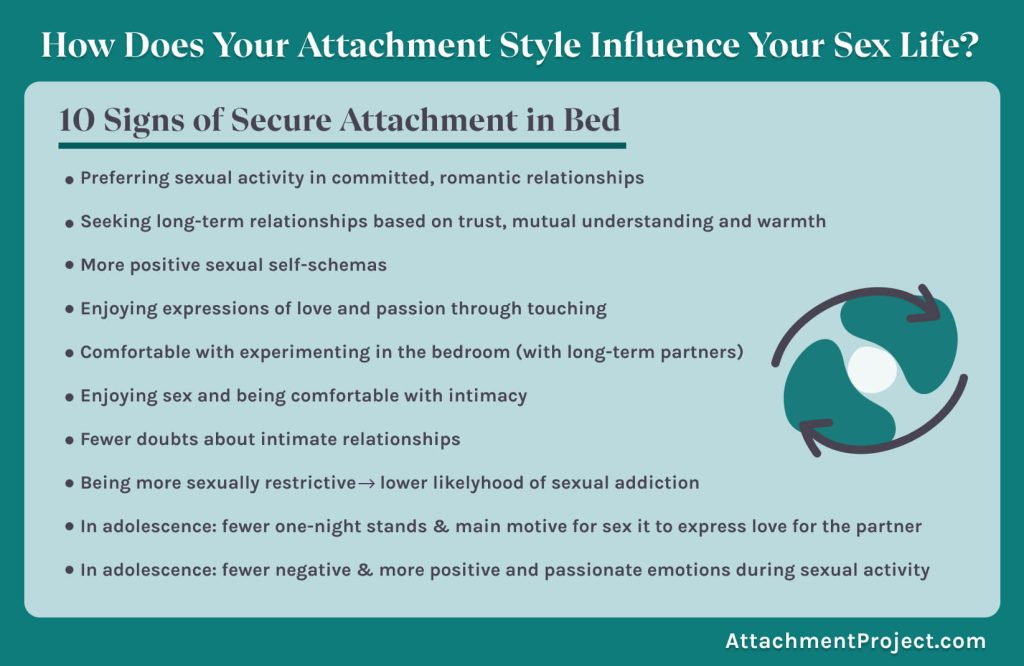Your Attachment Style Influences Your Sex Life [and even Casual Sex]

Published on September 13, 2020 Updated on November 25, 2023
Attachment styles play a role in the way we approach and experience sex. While secure attachment is associated with a fulfilling sex life, insecure attachment styles – anxious/preoccupied, dismissive/avoidant, and disorganized – have been linked to less satisfaction and more casual sex in intimate relationships.

Let’s meet three couples and dissect their sex lives
Late in the night, Jane has just finished a cozy candlelight dinner with her boyfriend, Matt. The two of them are drinking wine and engaging in a relaxed conversation. They are laughing, flirting, and soon, they head to the bedroom.
Jane and Matt kiss and caress each other gently but passionately. They pay close attention to the other’s emotions and reactions and are eager to satisfy each other’s desires…

At the same time, Jane’s brother, Tim, is on a first date with a girl he met online a couple of days ago. After a few drinks, Tim and his date, Ashley, leave the bar and head to Tim’s place. In a hurry to get Ashley to his apartment, Tim doesn’t pay much attention to what she says. He doesn’t want to hold her hand on the way.
He doesn’t know or care whether Ashley enjoyed what happened in the next few hours. In the morning, he asks her to leave, because he has to go out and run some errands. He never texts her again…
That same morning, Kate is drinking coffee and chatting online with Claire – a girl she’s been into for a few weeks. She really wants Claire to like her, but she’s not sure how to interpret her crush’s attitude. Is Claire even interested? Is she seeing or texting other girls too? Does Claire have feelings for her?

Kate has to know, she can’t relax. She keeps thinking about Claire and fantasizing about their perfect future relationship.
The two girls decide to go out for dinner later that day. Kate is anxious in her preparation for the date: what should she wear, how much make-up should she put on? The dinner goes well, but Kate is still not convinced that Claire is as smitten as she is. She invites Claire to her place and seduces her into the bedroom. She pleases Claire’s every wish and desire and disregards her own needs. Hopefully, Claire would like her better that way…
As we are peeping into our imaginary characters’ bedrooms, we notice the different experiences Jane, Tim, and Kate have with their sexual partners. For all three of them, these experiences are not only a one-time thing. They repeat them over and over again.
While Jane is pretty satisfied with her sex life, Tim and Kate are struggling. They don’t feel as much pleasure during sex: their needs are never truly met. Why?
Because they have unresolved and unaddressed attachment issues, which keep haunting them, even in the bedroom.
Let’s walk out of the bedrooms now and explore why and how early childhood attachment affects our sexual behaviors (and experiences) later in life.
How do attachment styles affect us in the bedroom?

Attachment styles form during early childhood but stick with us through adolescence and adulthood. They affect the way we perceive ourselves as individuals as well as the way we view social bonds in general.
Our attachment patterns predict (to a large extent) the way we approach and act in relationships. And since sex is a central and important part of intimate relationships, it would be logical to expect that attachment styles affect us in the bedroom.
There are four attachment styles:
- Anxious (Preoccupied)
- Avoidant (Dismissive)
- Disorganized
- Secure
Each of those styles predisposes us to how we will view, approach, and experience sex. While secure attachment often correlates with a fulfilling sex life, the other three – categorized as insecure – often lead to more problems in intimate relationships.
Find out more about how attachment influences intimacy in our article about attachment styles and sexual orientation.
Let’s go through each attachment style now. If you need a quick recap, check out our article on the four attachment styles.
Anxious Attachment: Uses sex for approval, falls in love easily and generally mistrusts their partner
The anxious/preoccupied attachment style is generally characterized by excessive worries about how one is perceived by others (therefore – anxious), and by an extreme desire for proximity, connection, and ‘merger’ with the attachment figure (therefore – preoccupied).
People with this attachment style often become obsessive and emotionally labile in their intimate relationships, due to strong fear of rejection. Even the most insignificant sign of unavailability from the partner might lead to extreme jealousy and demonstrations of anger and distrust.
Anxiously attached people also tend to feel under-appreciated or misunderstood by their lovers, or generally unsatisfied with the way they are being loved.
Such individuals will often become clingy, needy, and dependent on the attachment figure (in this case, the lover), which – paradoxically – might put off their partners and cause even more conflicts and frustration in the relationship.
When the relationship ends, it often leaves bitterness and resentment in the anxious individual. In other words, it’s not likely that you can ‘just be friends’ with an anxious person after you’ve been sexually involved with them.

Sexual behaviors of anxious adults are driven by attempts to make up for the perceived lack of love and security.
Anxiously attached individuals will constantly try to satisfy their need for feeling approved, appreciated, and desired.
They are likely to fall in love easily, even though they rarely believe that their partners are their true love. This is possibly because anxiously attached people often expect others to be unavailable and not interested in long-term commitment.
Additionally, anxious individuals tend to hold a generally negative perception of the self, and thus have lower self-esteem. They perceive themselves as unattractive and often doubt themselves.
If we combine anxiously attached people’s negative expectations and distrust towards the partner with their worries about worth and attractiveness, we see that this is a recipe for…let’s be real…bad sex.
This doesn’t necessarily mean that the sex itself is bad. It’s just not satisfying and pleasurable to the one that is in a constant state of worry and anxiety.
Accordingly, the anxiously attached group hold a negative perception of their sexual experiences. That could explain why these individuals tend to use fantasy as a substitute for intimacy. After all, you can always prevent abandonment and rejection in your fantasy, unlike in real life.
Nevertheless, when anxious individuals do engage in sexual encounters, they often do it for two main reasons:
- manipulation: to provoke the partner’s attentiveness, availability, and caregiving behaviors
- pursuit of proximity, reassurance, and approval
Despite their negative affect regarding sexual encounters, people with anxious attachment have more intimate partners (as compared to the other groups) and are prone to being unfaithful to their lovers.
As adolescents, these individuals consent to sexual activities in an attempt to prevent rejection and abandonment. Therefore, they are likely to agree to do things they don’t really want to do.
On the positive side, despite the likelihood of having many lovers, anxious individuals tend to remain cautious in the bedroom when it comes to using protection. They are more likely to use condoms during sex, which could be explained by their tendency to be more careful and fearful in general.
Avoidant Attachment: less likely to fall in love and more likely to engage in casual sex
Adults with an avoidant attachment style typically have a deactivated attachment system. Avoidant individuals do not seek proximity and intimacy, avoid the display of emotions, and appear distant and cold.
People who have this attachment style are less likely to fall in love, and they don’t seem to believe in ‘happily ever after’. They fear intimacy and tend to be less involved in relationships.
Their relationships are often unsatisfying, which they contribute to by engaging in relationally destructive behaviors – sabotaging the relationship.

For these reasons, avoidant individuals tend to have fewer long-term relationships and prefer to either abstain from sex or have short-term and casual sex encounters. They are likely to use fantasy or pornography as a substitute for intimacy (similarly to the anxious group) and engage in emotion-free sex.
Sex (and intimacy in general) can make avoidant adults uncomfortable
Considering that sex typically requires physical and psychological proximity, it can evoke discomfort in avoidant individuals. Therefore, adults with this attachment style often don’t enjoy their sexual experiences. They are also not likely to enjoy passionate and affectionate foreplay.
Their intimate behaviors are driven by their egos (for example, sex might lead to high status and prestige among peers) or by a desire to manipulate or control the partner. Avoidant adults are also likely to use sex simply to reduce stress (casual sex might be more convenient for them in this respect).
In adolescence, those with an avoidant attachment style perceive their sex drive as relatively low. If they do have sex, this might be driven by self-enhancing motives, such as losing their virginity.
Generally, avoidant adults don’t seem to use sex to express emotional proximity and love for their partners. This can be highly problematic if they have an anxious/preoccupied lover, who relies on sex to feel loved and desired.
You can find more informations in our “How to date someone with avoidant attachment” and “Avoidant attachment in relationships” guides!
Disorganized Attachment: feels unworthy of love, pursues casual sex and more likely to have a sex addiction

People with a disorganized (also referred to as fearful-avoidant) attachment style tend to score high in both anxiety and avoidance. For this reason, the characteristics of disorganized attachment are a blend of the anxious/preoccupied and avoidant/dismissive styles.
Disorganized individuals tend to swing between anxiety- and avoidance-driven behaviors, which creates an overall unstable and unpredictable behavioral pattern.
The same tendency is likely to apply to these individuals’ sexual interactions. For example, they might exhibit extreme passion and love for someone and then shut down their attachment systems during lovemaking, due to fear of intimacy.
Similar to the anxious group, disorganized adults see themselves in a negative light, have low self-esteem, and believe that they are not worthy of love.
They have difficulties trusting and relying on their lovers, and therefore, they often pursue emotion-free, casual sex. Seeking emotionless sex, on the other hand, is linked to a higher likelihood of sex addiction.
If disorganized individuals do enter a relationship, they often end up in passive, submissive, or secondary roles.
Secure Attachment: affectionate, seeks long-term relationships and less likely to engage in casual sex

Adults with secure attachment generally have low levels of both anxiety and avoidance. Securely attached individuals are less likely to worry about their self-worth or about their role in a relationship.
Instead, they tend to feel good about themselves and their love lives. They usually seek long-term and committed relationships based on trust, mutual understanding and emotional closeness.
Once they engage in such a relationship, securely attached adults feel satisfied with and positive about their sex lives. They are comfortable with experimenting and trying new things in the bedroom.
During adolescence, secure youngsters are less likely to engage in one-night stands or casual sex. They are also less likely to use sex to manipulate others or feed their egos.
The main reason for secure adolescents’ sexual encounters is to express affection for their lovers. As a result, such individuals already enjoy satisfying and passionate sex early in their lives.
How to Heal Attachment Issues and Thrive in the Bedroom?
Let’s go back to the characters from our story – Jane, Tim, and Kate. By now, you can probably identify their attachment styles (Jane is secure; Tim is avoidant; Kate is anxious).
But more importantly, it’s likely that you have found yourself in one of the ‘profiles’. If you can identify yourself as securely attached, that’s wonderful. Keep enjoying your relationship and your great sex life!
Keep in mind, though, that you might (at some point) enter a relationship with someone who is insecurely attached. And it’s not only yours but also your partner’s attachment style that predetermines your sex life and sexual satisfaction.
So, whether you are with someone who is insecurely attached, or you suspect that you yourself might have an anxious, avoidant, or disorganized attachment style, it’s important to work towards solving the issue.
Although it is possible to heal insecure attachment, remember that it takes time and hard work.
To find out more about the three types of insecure attachment and what you can do to overcome attachment disturbances, read our other articles on the four attachment styles: secure attachment, avoidant attachment, anxious attachment and disorganized attachment.
Follow us on Instagram
If you like this post and want to learn more about attachment theory, then we recommend following The Attachment Project on Instagram. We regularly post content to help you make sense of attachment theory in various contexts.

Sources:
Birnbaum, G. E., Reis, H. T., Mikulincer, M., Gillath, O., & Orpaz, A. (2006). When sex is more than just sex: Attachment orientations, sexual experience, and relationship quality. Journal of Personality and Social Psychology, 91, 929–943.
Zapf, J. L., Greiner, J., & Carroll, J. (2008). Attachment styles and male sex addiction. Sexual Addiction and Compulsivity, 15, 158–175.
*The outlined sources provide comprehensive overviews of previous research. You can find information about the original publications mentioned in these sources in their corresponding reference lists.















 Get mental health tips straight to your inbox
Get mental health tips straight to your inbox








